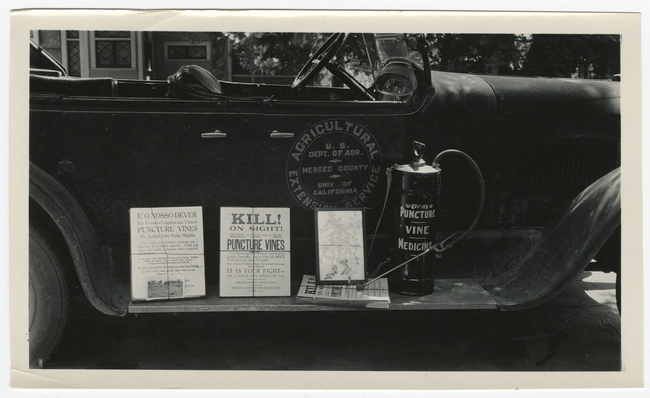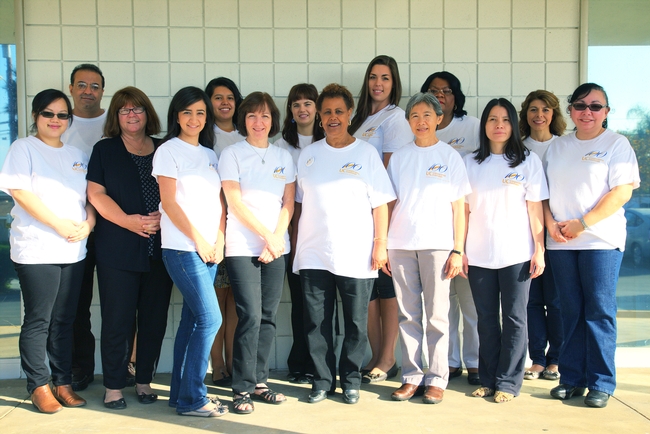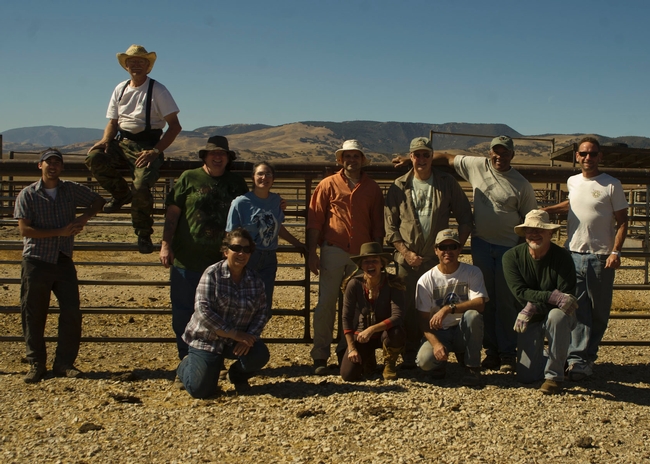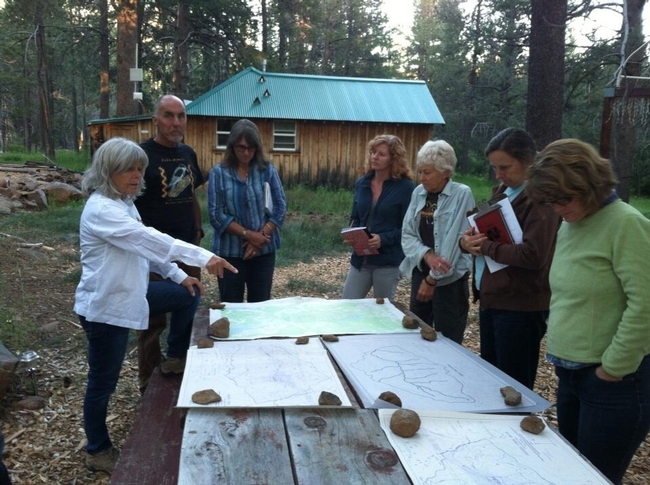Posts Tagged: Centennial
Federal grant to fund preservation of UCCE history
An ongoing effort to collect, digitally preserve and share 100 years of historical records by the UC Cooperative Extension (UCCE) has earned the UC Merced Library a more than $300,000 grant.
“We're extremely proud to be able to further the work already begun on the UCCE project,” UC Merced Chancellor Dorothy Leland said. “Our library is producing a collection that demonstrates the organization's lasting effects on the state, the work it has done in the past and its potential for the future.”
The work is especially relevant to the San Joaquin Valley, said Emily Lin, the UC Merced Library's Head of Digital Curation and Scholarship.
“We have a lot of archives and historic records based around urban centers, but we haven't been collecting the records of rural California in any systematic way,” she said. “But rural California has had an incredible influence on the state's history. California was transformed by agriculture over the past century.”
The Archivist of the United States approved the $308,900 grant from the National Historical Publications and Records Commission for “A Century of Impact: Documenting the Work of the Cooperative Extension in California's Counties.” The three-year project will begin in the summer, after Lin and others hire a group of undergraduate students to help with the work. Additionally, the project will be part of an informational booth at the World Ag Expo in February in Tulare — UC Merced's first appearance at the exposition, which draws more than 100,000 people from all over the world.
“We were convinced the history of Cooperative Extension in California was worthy of preserving when we launched the pilot project four years ago,” said Glenda Humiston, vice president of UC Agriculture and Natural Resources (UC ANR), the organization that oversees UCCE. “The federal grant to continue this work confirms the value of UCCE history and its contribution to California's prosperity.”
A pilot project, begun after the 2014 centennial of the UCCE, looked at Merced, Ventura and Humboldt counties' UCCE records, and produced a stack of material 70 linear feet long — just for Merced County. A banker box is about 1 linear foot.
Records from Humboldt County included disaster responses from the 1955 and 1964 historic floods, while Merced County's records were mainly about crops, irrigation, the beginnings of the Merced Irrigation District and 4-H. Each county's records provide insight into its unique characteristics, Lin said.
The new project will collect 100 years' worth of reports and historic photographs from 20 California counties — in the Valley, along the coast, up north at the edges of the Sierra and along the southern border — and will geocode all the records.
“This project is of great potential value in supporting a number of lines of existing research, as well as in opening up new and fruitful areas of inquiry into the interrelated topics of democracy, technology and community,” said David Campbell, a political scientist and the associate dean for social/human sciences in the College of Agricultural and Environmental Sciences at UC Davis. He wrote a letter of support for the project that was included in the application.
The digitization project will help researchers at all levels, Professor Mario Sifuentez said.
“It provides access to a trove of documents that shed light on the nature and development of agriculture in the region, which amazingly has been understudied,” he said. “Despite living in the heart of one of the most productive agricultural regions of the world, few people really understand how agriculture in the Central Valley works. I am invested in producing work and helping students produce work that explains the historical trajectory of how the Valley ended up as ‘The Valley,' and agriculture is the main component of that story.”
The archives set the stage for many research projects across many disciplines. Historians will find the records helpful, but so will people studying progressive era institutions, immigration, race relations, social movements, technological change or the rich history of food and agriculture in California, Campbell said. There are also implications for political science and public policy scholarship; environmental and climate studies around such topics as water and pesticide use; material for economists and labor market scholars; and geographers.
The library is working with the San Joaquin Valley Historical Society, and San Diego State University will also have a set of the records digitized when the project is completed. In addition, regional 4-H students will be part of the project, helping tag and digitize the material.
Cornell University Professor Scott Peters, a historian of higher education who wrote a letter of support for the project, said engaging with local students and their families through a 4-H project is particularly valuable.
“It's always important to help young people connect with the history of their communities,” Peters said. “These historical materials will enrich their understanding of the vision, values, ideals, tensions, dilemmas and struggles that the work of building a democratic culture in partnership with higher education requires and involves. And it helps them understand their own role in history and ask themselves what they are creating and leaving that will be part of history 100 years from now.”
After the 2014 centennial, UC ANR allocated funds to locate a professional archivist at the UC Merced library, which is becoming known for creating comprehensive digital collections of historical materials.
Archivist Lisa Vallen began work with the three pilot counties. She found UCCE records in the National Archives as well as pictures, negatives and documents spread throughout the state.
“Ideally, historical records should be kept in a space that's climate controlled,” Vallen said. “In Ventura, they have some in a container on a farm. That's not ideal at all.”
The ANR hopes this project will help not only researchers, but will educate the public and policy makers about UCCE.
“There's no question about the value of this project and the richness it brings to the whole state, not just UC,” said UC Merced University Librarian Haipeng Li.
Riverside County UC Cooperative Extension marks its 100th anniversary
On Nov. 12, UCCE puts the icing on the cake by bringing together key UC leaders, county supervisors, UC researchers, farm advisors and nutrition educators to provide perspective on the next century of Cooperative Extension in Riverside County.
“Back in 1914, the U.S. president and Congress realized that, to feed a great nation, ag research advances from top universities had to reach farmers,” said Eta Takele, the director of UCCE in Riverside County. “They made a bold move when they created Cooperative Extension, a program that revolutionized farming and communities. Over the years, we have worked side-by-side with farmers and their families to boost yields, maintain a safe food supply and protect natural resources.”
True to its form, UCCE is hosting an educational forum to mark the centennial. Presentations will run from 1 to 5 p.m. and cover such topics as the California drought, which is putting pressure on an agricultural industry in Riverside County that contributes $1.3 billion annually to the local economy. Director of the UC California Institute for Water Resources Doug Parker will explain how the UC Division of Agriculture and Natural Resources is responding to the crisis.
The statewide director of UCCE's 4-H and nutrition programs Constance Schneider will explain initiatives designed to reduce the alarming growth in overweight, obesity and Type 2 diabetes in California communities. In fact, the Riverside County's overweight and obesity rate is higher than average for California. Fourteen percent of Riverside County children ages 2 to 11 are overweight or obese and 36 percent of children 12 to 17 are overweight or obese.
Other speakers will address the UCCE working relationship with UC Riverside, new pest problems, issues related to waste management and the changing demographics of California. The program closes with a presentation on the future of UC Cooperative Extension by UCCE Vice Provost Chris Greer.
For more information, contact Eta Takele at (951) 683-6491, ettakele@ucanr.edu
Bakersfield gets a 'First Look' at UCCE centennial celebration
Brian Marsh, the director of UC Cooperative Extension in Kern County, talked about the upcoming UCCE centennial celebration with host Scott Cox on First Look, a web video and radio program that provides Kern County resident with an overview of the day's news. The program is broadcast on the Bakersfield Californian webpage and on KERN radio.
At a dinner Aug. 21 marking the 100th anniversary of UC Cooperative Extension, the organization will honor 14 Kern County families with a farming legacy that stretches back 100 years or more. Cox was impressed.
"For a family farm to be in business for 100 years, it's a tough way to make a living," Cox said. "There's a lot of temptation for kids to go off to school and learn how to do something else and sell the farm off. These are people who have stuck it out."
Marsh said the farming underway today is different than 100 years ago.
"The children are coming back to the farm with advanced degrees," Marsh said. "Farming isn't the simple life. .. There is a lot of technology, there's a lot of regulations to deal with. A lot of our products are exported, so you're dealing with international trade and residue concentrations in other countries."
Cox agreed. "From agribusiness, to science, there's a lot going on out there."
Marsh emphasized the importance of the California farming industry. "I like to eat everyday," he said.
State senator congratulates Tehama County UCCE
California State Sen. Jim Nielsen presented a senate resolution to the staff of UC Cooperative Extension in Tehama County last week to commemorate the organization's 100th anniversary, reported the Red Bluff Daily News.
He also spent several hours discussing current challenges and changes facing California agriculture. The article detailed the comments shared by the UCCE staff.
- County director Richard Buchner shared the history of UCCE and talked about orchard production in Tehama and nearby counties
- Farm advisor Allan Fulton discussed the local ground and surface water situation
- Farm advisor Josh Davy talked about work to improve livestock grazing land and other research priorities
- 4-H coordinator Lyn Strom shared her passion for the UCCE 4-H program
- CalFresh nutrition educator Darla Bandsma described how the nutrition program helps youth make healthy food choices
Other staff and interns at the office also had the opportunity to speak to the senator. Tehama County supervisor Burt Bundy spoke about his experiences in the California Agricultural Leadership Program and encouraged others to take part.
UC leads a long tradition of environmental stewardship in California
Stewardship: \'stü-?rd-?ship: the activity or job of protecting and being responsible for something.
In 1862 the Morrill Act was passed to support and maintain colleges of agriculture and mechanical arts, including a later provision that included the donation of public land. As one of the first land grant Universities, the University of California was well positioned to manage agricultural extension across the state as part of the Smith Lever Act of 1915. Today, many people think of California agriculture as strawberries, broccoli and rice; but it is livestock and forestry that dominated California working landscapes in those early days.
This year, the University of California Division of Agriculture and Natural Resources celebrates 100 years of UC Cooperative Extension serving as a research and outreach partner in communities throughout California. For an interesting read on this rich history and the evolution of UC rangeland management perspectives, see M. George, and W. J. Clawson's The History of UC Rangeland Extension, Research, and Teaching: A Perspective (2014). Additionally, UC ANR California Rangelands Website includes a free Annual Rangeland E-book; current project descriptions, publications, and online learning modules: http://californiarangeland.ucdavis.edu/.
Maintaining and improving environmental quality on public and private land requires an informed strategy that encourages stewardship by land owners and community members. In present times, we face the challenges of managing land in the face of growing population, drought, invasive species, and climate change, just to name a few forces of global change. Out of necessity, our broader perspective on land management has shifted to one of “ecosystem stewardship” which is defined as a strategy to respond to and shape social-ecological systems under conditions of uncertainty and change to sustain the supply and opportunities for use of ecosystem services to support human well-being (Chapin et al. 2010). The stewardship framework focuses on the dynamics of ecological change and assesses management options that may influence the path or rate of that change.
The California Naturalist Program uses a science curriculum which includes chapters in forest, woodland, and range resources and management, geology, climate, water, wildlife, and plants. Experiential learning and service projects instill a deep appreciation for the natural communities of the state and serve to engage people in natural resource conservation.
California Naturalists trained at these locations and more are involved in ecosystem stewardship, rangeland management, watershed restoration, and helping outdoor education programs that benefit the environment and people of all ages. Naturalists have donated over 13,000 hours of in-state service in the last three years. These types of stewardship opportunities are essential for the active adaptive management that both public and private lands need to ensure resilience and continue to provide ecosystem services that we all rely on. These trained environmental stewards are an important part of this growing community of practice who not only steward land but pass on critical knowledge about California's natural and managed ecosystems.









